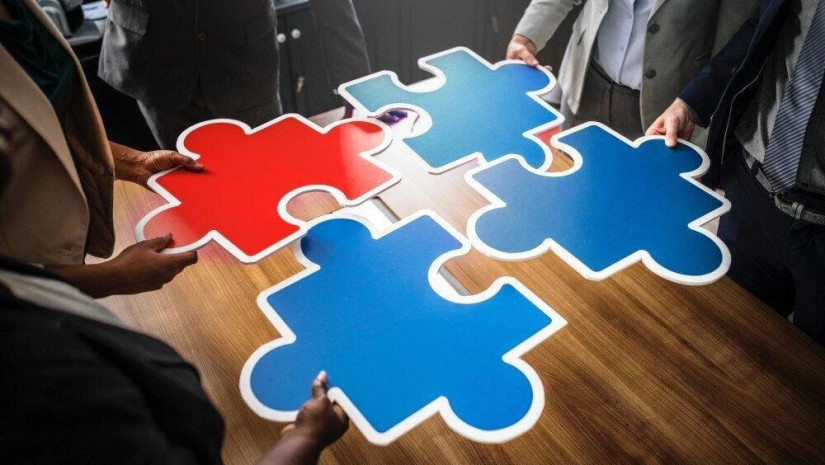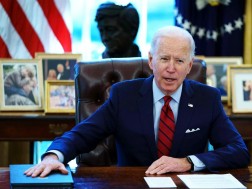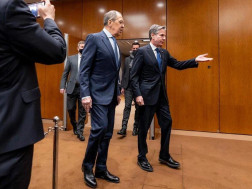The first meeting of heads of state and government of India, Israel, the United States and the United Arab Emirates (UAE) — dubbed the West Asian “Quad possibly see the announcement of a joint venture partnership on storage facilities for energy from renewables and another on the establishment of food corridors.
Also known as the “I2U2,” the meeting on Thursday will bring together the prime ministers of India and Israel (I2) – Narendra Modi and Yair Lapid — and the presidents of the US and the UAE (U2), Joe Biden and Mohammed bin Zayed al Nahyan. The new alignment is set against the backdrop of economic and political risks in an increasingly uncertain world with high inflation, soaring food and fuel prices and a pandemic that upended established ways of doing business.
Joining the West Asia Quad is part of the “hedging” strategy adopted by a large number of countries, Talmiz Ahmed, former Indian ambassador to Saudi Arabia, Oman and the UAE, told Al Jazeera. “With the world in turmoil, no one knows what will work. So countries are hedging their bets” and joining and forming groups that they think will work best for them, Ahmed said.
The summit meeting is to take place on the second day of Biden’s three-stop July 13-16 tour of Israel, the occupied West Bank and Saudi Arabia. This is Biden’s first visit to the region since he took office in January last year. Modi is to participate in the meet virtually.
The I2U2 is aimed to “encourage joint investments” in six mutually identified areas such as water, energy, transportation, space, health, and food security, according to an Indian government statement on Tuesday. It intends to mobilise private-sector capital and expertise to help modernise the infrastructure, develop clean energy for industries, improve public health, and promote the development of critical emerging and green technologies, the statement said, adding that the “projects can serve as a model for economic cooperation and offer opportunities for our businesspersons and workers”.
Briefing reporters last month in Washington, DC, US State Department Spokesperson Ned Price had also underlined the economic agenda of the grouping.
“Each of these countries are technological hubs,” he said while India was also “a massive market. It is a massive consumer market”.
Expectations from the Summit
With all the leaders participating in Thursday’s summit, it is seen as a move to institutionalize the so-called West Asian Quad which, in turn, provides a framework that will help convert “government-to-government ideals into concrete programmes that will allow business-to-business interactions,” said Pramit Pal Chaudhuri, fellow at the New Delhi-based Ananta Aspen Centre think tank.
For instance, the potential announcement of a venture in renewable energy storage.
“The storage of energy generated from renewables is most critical. At present there are no technologies for this,” an Indian energy ministry official who is not authorised to speak to the media, said, adding that electricity generated from a renewable source was linked immediately to a grid without storing it. The new business joint venture would look at critical storage technology, the official added.
This could feed into India’s efforts to reach net-zero emissions by 2070, a goal announced by Prime Minister Modi in Glasgow, Scotland, last year. At the time, India also announced plans to triple its renewable energy capacity to 500 gigawatts (GW) by 2030 from 157GW in March 2022.
“Energy storage technologies have a key role to play in advancing the decarbonisation of the power and mobility sectors. By helping manage the intermittency of renewable energy [RE] generation, storage can facilitate deeper RE penetration into the electricity grid,” said Arjun Dutt, programme lead for Energy Finance at the Council on Energy, Environment and Water think tank. “Amid a complicated geopolitical landscape, the greater decentralisation of supply chains of key technologies is a priority for many countries.”
The summit is also expected to yield an announcement on a food corridor between India and the UAE. The joint corridor revolves around plans by UAE investors like the Dubai-based Emaar Group to invest up to $5bn in mega food parks in India and another $2bn in contract farming, sourcing of agro commodities and related infrastructure. While the idea of the corridor was mooted three years ago and is aimed at ensuring food security for the UAE, it has become more significant now given the global food crisis, driven partly by grains stuck in ports on the back of the Russia-Ukraine war.
The war in Ukraine and rising inflation and food prices are among the subjects on the table for the leaders at the summit, besides the Iran nuclear deal.
The idea of a joint food corridor for the UAE’s food security was inspired by India’s strategic petroleum reserve in Padur in southern India which is in partnership with the Abu Dhabi National Oil Company. Similarly, the UAE could have a food reserve in India, Indian officials associated with the food corridor project.
“The food corridor between India and UAE is beneficial for both countries,” said Siraj Hussain, a former agriculture secretary.
In 2020, India exported food including cereals, sugar, fruits, vegetables, tea, meat and seafood, among others, worth $1.89bn and imported food items for $363m.
With a bilateral trade of $59bn, the UAE was already India’s third-largest trading partner after China and the US for 2019-20, as per the latest government data.
With the India-UAE free trade pact in place, trade in goods between the two countries is expected to clock in at more than $100bn and trade in services to more than $15bn within five years. India is also looking at concluding a free-trade pact with Israel, all of which is likely to give an additional boost to the regional Quad.
“A formal agreement with India can provide long term food security to UAE for several food items,” Hussain added.
The West Asia “Quad”
The two announcements – when made – will aim to give a certain degree of credence to a grouping that its critics have trashed as “devoid of logic” and of “no strategic value”.
“We believe that there will be many more projects that will emerge cementing the group’s credentials. These will be practical efforts that will show that the I2U2 is more than a talking shop,” said the Indian energy ministry official quoted above.
The first meeting of the I2U2 grouping took place on October 18 last year during a visit to Israel by Indian Foreign Minister S Jaishankar, who joined his then counterpart Lapid for the talks, with UAE Foreign Minister Abdullah Bin Zayed Al Nahyan and US Secretary of State Antony Blinken joining from their respective capitals.
An Israeli readout of the October discussions said the four countries had “decided to establish an international forum for economic cooperation” exploring “possibilities for joint infrastructure projects in the fields of transportation, technology, maritime security, and economics and trade, as well as for additional joint projects”.
The I2U2 came together on the back of the momentum created by the Abraham Accords — brokered by the Trump administration two years ago to normalize ties between Israel and Arab countries including Bahrain, the UAE and Morocco.
India, along with US, Australia and Japan, is already part of the present Quad that came into place in 2017 against China, seen as belligerent in the Indo-Pacific region.
Analysts are divided over whether China is a factor for the I2U2 coming together in West Asia.
Akshobh Giridharadas, analyst at the New Delhi-based Observer Research Foundation (ORF) think tank, says that the West Asian Quad “reflects the Biden administration’s alacrity at a China containment policy”.
“For Washington, there is a categorisation of enemies: the historical one in Iran; the cyclical one in Russia; and the new strategic one in China,” he wrote in an article for the ORF adding that as Beijing increases its engagement with the UAE and Israel, Washington wants to “negate” Chinese presence in the region, whether through military or political means, or trade. “Despite the historic and long alliance with Abu Dhabi and Tel Aviv, there is concern over Beijing’s influence in the region.”
Anantha Aspen’s Chaudhuri disagrees. The UAE, he says, is the “primary driver” of the I2U2 with its desire to shape the post-American and the post-oil future of the Persian Gulf. “It wishes to become an economic and technological hub which is why India, Israel and the US are important to the endeavor,” he told Al Jazeera.
P R Kumaraswamy, a professor at Jawaharlal Nehru University in New Delhi and an expert on West Asian affairs, agrees.
“India has had good relations at the bilateral level with Israel, the US and the UAE. This has now been elevated to a regional grouping. This is new for Israel and India as Israel has never been part of a regional grouping in the region before [the Abraham Accords],” Kumaraswamy said.
Prior to the accords, India had to keep its ties with Israel and the Arab states separate. Now with the pacts in place, India can enter into a regional pact which is “an enormous departure from the past,” Kumaraswamy said, adding that the I2U2 complements India’s desire for a greater role on the global stage. “It is not an anti-Iran or an anti-China grouping,” he added, Al JAzeera reports.















